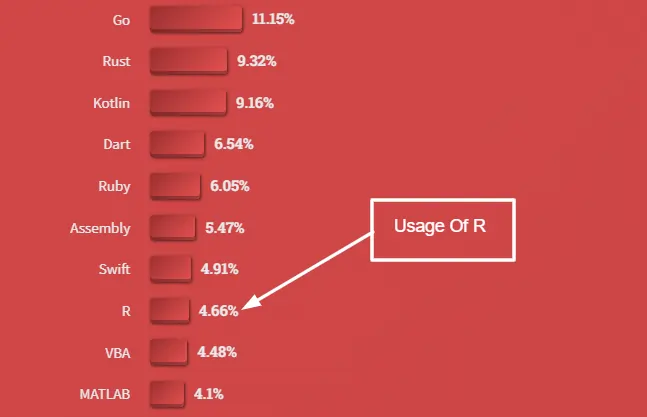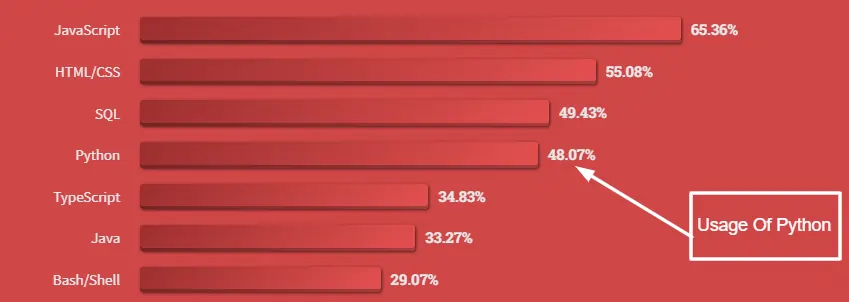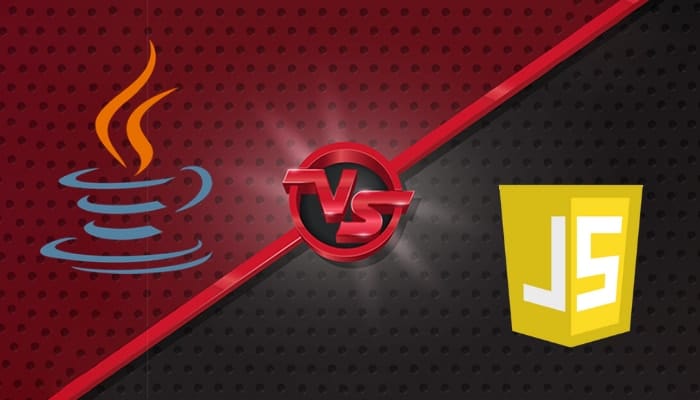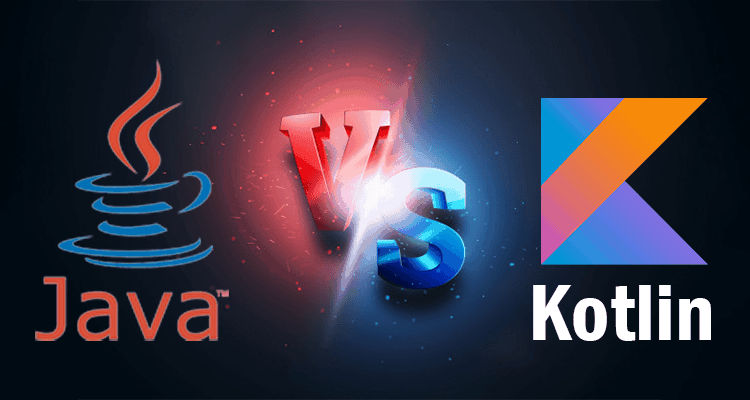R vs Python is always a major difference for data science students. The students always look for the best answer for R vs Python. In this blog, we are going to share with you the comparison between R vs Python for data science course. Here we go:-
R is primarily used for statistical analysis. While Python provides a more general approach to data science. R and Python are object-oriented toward data science.
Learning both is an ideal solution. Python is a common-purpose language with a readable syntax.
Every programming language has its own Intended purposes like Python suitable for Data Analysis. But we can’t use this for statistical methods. We use Python in machine learning applications. We also use it for data transformations and building apps. Python, as a general-purpose language, is easy to use and highly adaptable for various tasks in a data science consulting firm.
What is R Programming?
Table of Contents
R is an open-source language. Any source code can quickly identify what is happening on the screen. One can add a feature and fix the bugs without waiting for the vendor. It always allows us to integrate with other languages (C, C + +). This enables you to interact with multiple data sources and statistical packages.
R Programming Statistical Features
R and its library introduce a variety of statistical and graphical techniques. These techniques include linear and non-linear modeling, classical analytical testing, time-series analysis, etc. This is easily extensible through functions and extensions. And R is known for its active contributions in terms of community packages.
Many of the R’s standard features are written in R itself. Which makes it easy for users to follow the algorithmic options made. For computationally intensive parts, C, C + + and Fortran code can be linked. And called at run time. Get the best R programming assignment help.
Applications of R
- R is used in fundamental tools of finance
- It is considered as an alternate execution of Science
- R is the most Prevalent language
- Best for Data Science
- R help in Data importing and Cleaning
Advantages Of R
Following are the main advantages of the R programming language.
- Free and open-source: R is free and open-source software, which means that it is available for anyone to use and modify without any cost. This makes it accessible to many users, for example, individuals, small businesses, and academic institutions.
- Wide range of statistical and graphical capabilities: R has a vast range of built-in statistical functions and packages. It allows users to analyze and visualize data in various ways. It can handle various statistical analyses, including linear and nonlinear modeling, time-series analysis, and multivariate statistics.
- Large and active user community: R has a large and active user community that regularly contributes to its development, documentation, and maintenance. This community ensures that R remains relevant and up-to-date with new statistical and graphical methods.
- Cross-platform compatibility: R runs on all major operating systems, including Windows, macOS, and Linux. It is easy for users to share their work with others, regardless of their computing platform.
- Integration with other programming languages and tools: R can be integrated with other programming languages and tools, such as; Python, C++, and SQL. It is a versatile tool for data analysis and modeling.
Disadvantages Of R
Here are the following disadvantages of the R
- Weak origin
- Data handling
- Basic security
- Complicated programming language
- Lesser speed
Why Choose R & Its Usage?

R was created by scientists. It is made to solve challenges in statistics, machine learning, and data science. R has powerful communication libraries, so R is an ideal tool for data science. R has several packages for performing panel data analysis, time series analysis, and data mining. Furthermore, there are no better tools available than R.

What is Python Programming?
The Python programming language is one of the most sought-after programming languages. In the IT industry. Along with being one of the best original languages for beginners. Python is an all-around programming language for professionals too. If you are studying Python programming and need help with python homework, hire our experts.
Advantages Of Python
These are the some advantages of python, that’s given below.
- Easy to learn: Python has a simple syntax and is easy to learn and understand, even for beginners, and it’s a good choice for new programmers.
- Large community and support: Python has a large and active community of developers, which means there are plenty of resources, libraries, and documentation available. This makes it easier for programmers to find help and collaborate with others.
- Versatile and flexible: Python can be used for many applications, including web development, data analysis, machine learning, artificial intelligence, scientific computing, and more. It is also compatible with most operating systems.
- Readable and maintainable code: Python code is easy to read, write, and maintain, which helps reduce the cost of developing and maintaining software.
- High-level language: Python is a high-level language that provides abstractions that simplify programming tasks, such as memory management and garbage collection. This helps to reduce development time and increase productivity.
Disadvantages Of Python
Here are the main disadvantages of Python.
- It has a slow speed.
- Not memory efficient
- Weak in mobile computing
- Runtime errors
- Database access
Applications of Python
- Web and Internet Development
- Desktop GUI Applications
- Scientific and Numeric Applications
- Software Development Application
- Python Applications in Education
- Python Applications in Business
- Database Access
- Network Programming
Why Choose Python & Its Usage?
Guido van Rossum, a computer programmer, created Python in 1991. For AI, statistics, and math, python has several useful libraries. As a pure Machine Learning player, python can be viewed. Also, python isn’t quite ready for econometrics and communication yet. For deploying and integrating Machine Learning, python is one of the best tools, but not for business analytics.

These are the most commonly used programming language. Javascript, HTML/CSS, SQL, Python, and TypeScript are almost connected as the most popular languages for people learning to code. Python is the 4th one most used programming language in the world. People learning to code are likelier than Professional Developers to report using Python (58% vs 44%).
And the second thing is Python is the right choice if you want to do more than statistics, such as deployment and reproducibility. R is the right choice to make a report or develop a dashboard.
Which one is easy, R vs Python?
In R, in the beginning, it’s a big learning curve. But as soon as you know the basics, you can learn high-level stuff. And a good thing about R is that it’s not hard for skilled programmers.
R is the best option because it is very much inflow and, Big MNCs. The R programming language is used everywhere in the small-scale.
Python is very readable. You will not waste a lot of time remembering the arcing syntax. It is quite easy than that other programming languages. In simple words, Python is easy to learn. But it is slower than the other languages.
Job Prospects in R Programming and Python Programming
International organizations hiring for R developers. Companies like Acer, Accenture. Some MNC have started building their employees to specialize in R. Since R is a tool for a data scientist. Besides, it can make you get higher packages in multinational companies.
R employments are not exclusively being offered in the IT sector. However, a wide range of organizations are procuring high paid R applicants including
- Retail associations
- Banks
- Social insurance associations
- Financial firms
New businesses have an interest in R software engineers. R employment opportunities with different positions like:
- R information researcher
- Information scientist(IT)
- Expert director
- Senior information expert
- Business expert
- Expert specialist
In the meantime, associations anticipate a large number of new contracts. It should officially be outfitted with learning of R. They need them to be acquainted with the R. And how to utilize it for information investigation.
Difference between R Vs Python
| R | Python | |
| 1. Objective Of R vs Python | Statistics and data analysis | Production and deployment |
| 2. Primary Users | Scholar and R & D | Programmers and developers |
| 3. IDE | Rstudio | Ipython Notebook, Spyder |
| 4. Integration | It runs locally. | With the app it is Well-integrated |
| 5. Flexibility in R vs Python | The library is simple to use. | It’s simple to create new models. Matrix computation and optimization, to be specific. |
| 6. Learning curve | In the beginning, it is Difficult | It is Smooth and Linear |
| 7. Important Library and Packages | caret, ggplot2, zoo, tidyverse | caret, scipy, TensorFlow, sci-kit-learn, pandas |
| 8. Database size | Larger sizes can be handled. | Larger sizes can be handled. |
| 9. Task | Primary results are simple to obtain. | The algorithm is easy to use |
| 10. Advantages of R Vs Python | Graphs are designed to communicate. A large data analysis catalog is available. GitHub’s user interface RMarkdown Shiny | Computations in mathematics Jupyter Notebooks: Notebooks make it easier to share information or data with others. Deployment Readability of the code Speed Function in Python |
| 11. Disadvantages | Between the library learning curve, dependencies is slow and high. | There aren’t as many libraries as there are in R. |
Let’s Sum up R vs Python
Now, you have a definite examination of R vs Python. You can utilize it is possible that one for information investigation and information science.
Hope, you might be confident to pick the best as per your needs. On the off chance that you are a student of R programming language. At that point, you can get the best R programming assignment help from us. Also, stand a chance to get extra discounts.
FAQs
Can Python replace R?
Yes, Python can replace R because there are some tools (like as the feather package) that allow us to interchange data and code between R and Python in a same project.
Why Is R Preferred Over Python?
R is commonly used when data analysis requires standalone analysis (breakdown) and processing.
Is R Easier Than Python?
Python and R are fairly easy languages to learn. Python was originally designed for software development.



